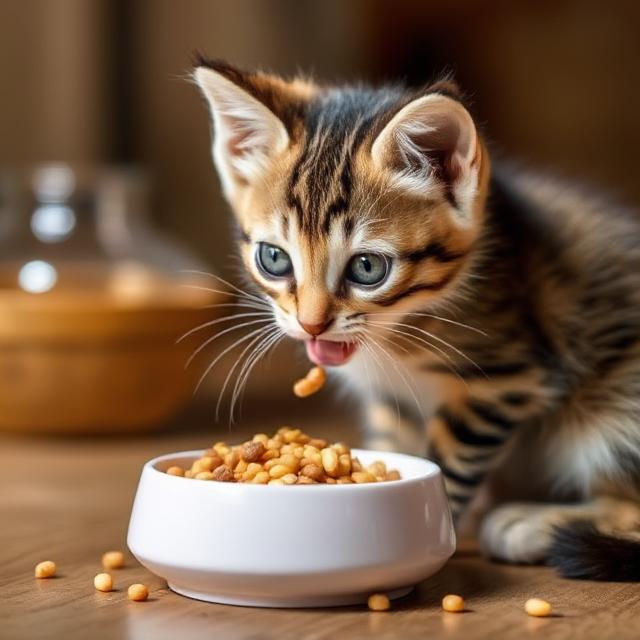What to feed a kitten
What to Feed a Kitten: A Complete Guide for Healthy Growth Bringing home a kitten is an exciting and heartwarming experience. These tiny furballs require special care, attention, and above all, proper nutrition to ensure they grow into healthy and happy adult cats. Feeding a kitten is not the same as feeding an adult cat, as kittens have unique dietary needs during their early stages of life. In this guide, we will explore what to feed a kitten, how much to feed, and tips to ensure they get the best start in life.
Why Proper Nutrition Is Essential for Kittens
Kittens grow at an incredibly fast rate, especially during the first six months of their lives. During this period, they need a balanced diet rich in protein, fats, vitamins, and minerals to support their growth, energy levels, and overall development. What to feed a kitten
-
Protein helps build strong muscles and tissues.
-
Healthy fats provide energy and support brain development.
-
Calcium and phosphorus strengthen bones and teeth.
-
Vitamins and minerals ensure proper organ function and immune support.
A poorly balanced diet can lead to stunted growth, weak immunity, or long-term health issues. Therefore, knowing what to feed a kitten is the foundation of responsible pet parenting.
Feeding a Newborn Kitten (0–4 Weeks Old)
If your kitten is less than four weeks old, they are still in the neonatal stage and depend entirely on milk. Ideally, they should receive their mother’s milk, as it contains essential antibodies and nutrients for immunity and growth.
However, if the mother is not available or unable to nurse, you will need to provide a kitten milk replacer (KMR). Do not feed cow’s milk, as it can cause diarrhea and digestive issues. What to feed a kitten
Feeding Schedule for Newborns:
-
0–2 weeks old: Every 2–3 hours, even during the night.
-
2–4 weeks old: Every 3–4 hours, gradually increasing the amount of milk.
Always use a kitten feeding bottle or syringe and keep the milk warm (but not hot). After feeding, gently stimulate the kitten’s belly to help them urinate and defecate, just as their mother would.
Transition to Solid Food (4–8 Weeks Old)
At around 4 weeks, kittens start to develop teeth and can slowly transition from milk to solid food. This stage is called weaning.
What to Feed:
-
Wet kitten food: High in moisture and easy to chew.
-
Moistened dry kitten kibble: Soften it with warm water or kitten milk replacer.
Start by offering small amounts and gradually increase as they get used to the texture.
Feeding Frequency:
-
4–6 weeks: 4–5 small meals per day.
-
6–8 weeks: 3–4 meals per day.
Ensure fresh water is always available, as kittens begin to rely less on milk for hydration.
Feeding Kittens (2–6 Months Old)
By two months, kittens are more active and playful, and their nutritional needs remain high. This is the stage where they experience rapid growth and need plenty of calories.
Best Food Options:
-
High-quality wet kitten food – Moisture-rich and highly digestible.
-
Dry kitten food – Provides crunch for dental health (choose kitten-specific formulas).
A mix of both wet and dry food often works best. Wet food ensures hydration, while dry food supports dental strength.
How Much to Feed:
Check the feeding guidelines on your kitten food packaging, as calorie content varies. Generally, kittens eat about:
-
½ to 1 cup of dry food per day, or
-
3–4 small portions of wet food daily.
Feeding Kittens (6–12 Months Old)
At six months, your kitten starts to approach adolescence. Growth slows slightly, but they still require a kitten-specific diet until they reach one year of age.
Feeding Tips:
-
Feed 2–3 meals per day.
-
Continue offering a mix of wet and dry food.
-
Avoid giving too many treats – they should not exceed 10% of daily calories.
After 12 months, you can slowly transition them to adult cat food.
Foods to Avoid for Kittens
Not everything that seems edible is safe for kittens. Some foods can be toxic or harmful to their health. What to feed a kitten
-
Cow’s milk and dairy products – Can cause digestive upset.
-
Onions, garlic, and chives – Toxic to cats and can damage red blood cells.
-
Chocolate, caffeine, and alcohol – Highly toxic and potentially fatal.
-
Bones and raw fish – Risk of choking, splinters, or parasites.
-
Dog food – Lacks the essential nutrients cats need, especially taurine.
Should You Give Supplements?
If your kitten is on a high-quality, commercially prepared kitten diet, supplements are usually unnecessary. Over-supplementing can cause more harm than good. Only give vitamins or minerals if your vet specifically recommends them.
Homemade Food for Kittens – Is It Safe?
What to feed kitten . Some pet owners prefer homemade diets for their kittens. While this can be done, it requires expert planning to ensure the food meets all nutritional requirements. An unbalanced homemade diet can lead to deficiencies and serious health problems.
If you choose this route, consult a veterinarian or a feline nutritionist to create a proper recipe.
Additional Tips for Feeding Kittens
-
Always provide fresh water. Hydration is vital for kidney and urinary health.
-
Use shallow bowls. Kittens have small faces and find it easier to eat from shallow dishes.
-
Stick to a schedule. Consistent feeding times help maintain a healthy routine.
-
Monitor weight and growth. Healthy kittens steadily gain weight each week.
-
Introduce new foods gradually. Sudden changes can upset their stomachs.
Conclusion
Feeding a kitten properly is one of the most important responsibilities of a cat owner. From milk in the early weeks to a well-balanced kitten food diet as they grow, the key is providing the right nutrients at the right time. Always choose high-quality kitten food, ensure they get enough calories for their age, and consult your veterinarian if you’re unsure about their diet.
By following these guidelines, you’ll give your kitten the best possible start in life – setting them up for a lifetime of health, happiness, and purrs


